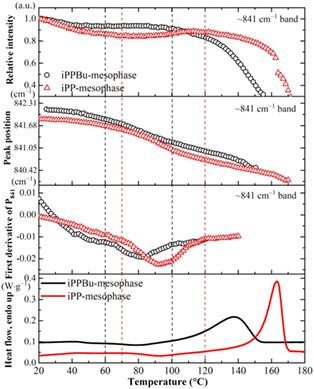当前位置:
X-MOL 学术
›
Polym. Int.
›
论文详情
Our official English website, www.x-mol.net, welcomes your
feedback! (Note: you will need to create a separate account there.)
Structural evolution of mesomorphic propylene–1-butene random copolymer during heating process
Polymer International ( IF 2.9 ) Pub Date : 2021-09-22 , DOI: 10.1002/pi.6303 Chengao Qian 1, 2 , Ying Zhao 1 , Dujin Wang 1, 2
Polymer International ( IF 2.9 ) Pub Date : 2021-09-22 , DOI: 10.1002/pi.6303 Chengao Qian 1, 2 , Ying Zhao 1 , Dujin Wang 1, 2
Affiliation

|
The study of the transition of mesophase to α-crystal (meso–α transition) is of great significance for understanding the crystallization, morphology as well as processability of polypropylene materials. The structural evolution of mesomorphic isotactic propylene–1-butene (iPPBu) random copolymer during the continuous heating process was investigated using in situ Fourier transform infrared spectroscopy, differential scanning calorimetry, wide-angle X-ray diffraction and dynamic mechanical analysis. The presence of the butene comonomer influences the meso–α transition behavior. Compared with the mesomorphic iPP homopolymer, the presence of butene comonomer reduces both onset temperature (Tonset) and end temperature (Tend) of the meso–α transition, and narrows the transition temperature range. The content of the 31 helical sequence with 12 monomers remains invariant during the meso–α transition, differing from that of mesomorphic iPP homopolymer. Similar to mesomorphic iPP homopolymer, the 31 helical sequence with monomer number n ≤ 12 is found to exist in the rigid amorphous fraction of iPPBu, but is different from that of a mesomorphic propylene–ethylene random copolymer. In the meso–α transition (from 60 to 100 °C), the redshift of the peak position of the band at ca 841 cm−1 provides new information for the approaching of adjacent stems at the molecular level. Moreover, a new peak at around Tend is found in the tan(δ)–T plot, and is correlated with the meso–α transition. The activation energy of the meso–α transition of mesomorphic iPPBu is 32.5 kJ mol−1, which is slightly lower than that of mesomorphic iPP homopolymer. This work sheds new light on further understanding of the meso–α transition mechanism of iPPBu copolymer at the molecular level and elucidates the effect of butene comonomer on the meso–α transition. © 2021 Society of Industrial Chemistry.
中文翻译:

加热过程中介晶丙烯-1-丁烯无规共聚物的结构演变
中间相的与过渡的研究α型结晶(内消旋α转变)具有重要的意义理解的结晶,形态以及聚丙烯材料的加工性。使用原位傅里叶变换红外光谱、差示扫描量热法、广角 X 射线衍射和动态力学分析研究了介晶全同立构丙烯-1-丁烯 (iPPBu) 无规共聚物在连续加热过程中的结构演变。丁烯共聚单体的存在影响内消旋-α转变行为。与介晶 iPP 均聚物相比,丁烯共聚单体的存在降低了两者的起始温度(T onset)和中间-α转变的结束温度(T end),并缩小了转变温度范围。具有 12 个单体的 3 1螺旋序列的含量在中间 - α转变期间保持不变,与中间晶 iPP 均聚物的含量不同。与介晶 iPP 均聚物相似,单体数n ≤ 12的 3 1螺旋序列被发现存在于 iPPBu 的刚性无定形部分中,但不同于介晶丙烯-乙烯无规共聚物。在中-α转变(从 60 到 100 °C)中,带峰位置的红移在ca 841 cm -1为在分子水平上接近相邻茎提供了新的信息。此外,在 tan( δ ) -T图中,在T端附近发现了一个新峰,并且与 meso- α转变相关。介晶iPPBu的介观-α转变的活化能为32.5 kJ mol -1,略低于介晶iPP均聚物。这项工作为在分子水平上进一步了解iPPBu 共聚物的内消旋-α转变机理提供了新的思路,并阐明了丁烯共聚单体对内消旋-α转变的影响。© 2021 工业化学学会。
更新日期:2021-09-22
中文翻译:

加热过程中介晶丙烯-1-丁烯无规共聚物的结构演变
中间相的与过渡的研究α型结晶(内消旋α转变)具有重要的意义理解的结晶,形态以及聚丙烯材料的加工性。使用原位傅里叶变换红外光谱、差示扫描量热法、广角 X 射线衍射和动态力学分析研究了介晶全同立构丙烯-1-丁烯 (iPPBu) 无规共聚物在连续加热过程中的结构演变。丁烯共聚单体的存在影响内消旋-α转变行为。与介晶 iPP 均聚物相比,丁烯共聚单体的存在降低了两者的起始温度(T onset)和中间-α转变的结束温度(T end),并缩小了转变温度范围。具有 12 个单体的 3 1螺旋序列的含量在中间 - α转变期间保持不变,与中间晶 iPP 均聚物的含量不同。与介晶 iPP 均聚物相似,单体数n ≤ 12的 3 1螺旋序列被发现存在于 iPPBu 的刚性无定形部分中,但不同于介晶丙烯-乙烯无规共聚物。在中-α转变(从 60 到 100 °C)中,带峰位置的红移在ca 841 cm -1为在分子水平上接近相邻茎提供了新的信息。此外,在 tan( δ ) -T图中,在T端附近发现了一个新峰,并且与 meso- α转变相关。介晶iPPBu的介观-α转变的活化能为32.5 kJ mol -1,略低于介晶iPP均聚物。这项工作为在分子水平上进一步了解iPPBu 共聚物的内消旋-α转变机理提供了新的思路,并阐明了丁烯共聚单体对内消旋-α转变的影响。© 2021 工业化学学会。











































 京公网安备 11010802027423号
京公网安备 11010802027423号